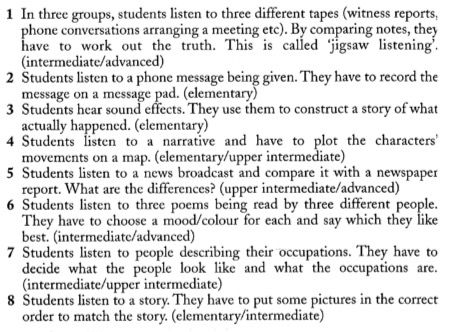Chapter 7: How to teaching reading?
There are mainly:
1. two types of reading: extensive reading (for pleasure) & intensive reading (in class + study activities).
2. Three reading skills: scan the texts (for particular bits of information they’re teaching for) & skim (cast their eyes over its surface - to get a general idea of what it is about) & detailed comprehension.
3. Six reading principles: encourage students to read as often and as much as possible; students need to be engaged with what they are reading; encourage students to respond to the content of a text (and explore their feelings about it), not just concentrate on its construction; prediction is a major factor in reading; match the task to the topic when using intensive reading texts; good teachers exploit reading texts to the full.
4. 7 methods to arouse students’ interest: jigsaw reading; reading puzzles; using newspapers; following instructions; poetry; play extracts; predicting from words and pictures.
Chapter 8: How to teaching writing?
2 purposes of writing:
1. Writing for learning: help students practice and work with language they’ve been studying
2. Writing for writing: develop the students’ skills as writers
Before writing, students have to know the genre, the writing process and build the writing habit.
Writing materials:
Instant writing, using music and pictures, newspapers and magazines, brochures and guides, poetry.
Collaborative writing:
1. Dictogloss (hear a story and retell it);
2. Story circle (one sentence by each);
3. Writing to each other (live chat, pen pal, keypals)
4. Writing in other genres
Chapter 9: How to teaching speaking?
What kind of speaking should students do?
The students are using any and all the language at their command to perform some kind of oral task. The important thing is that there should be a task to complete and that the students should want to complete it.
Why encourage students to do speaking tasks?
Rehearsal; feedback; engagement
What do speaking activities to do speaking tasks?
Methods to decrease information gaps:
Describe and draw; story-telling activity; surveys; discussion; role-play
How should teachers correct speaking?
Constant interruption from the teacher will destroy the purpose of the speaking activity.
As with any kind of correction, it is important not to single students out for particular criticism.
Chapter 10: How to teaching listening?
Why teach listening?
Exposing students to spoken English (different types)
Let them hear different varieties and accents
Help students to acquire language subconsciously
What kind of listening should students do?
Play different kind of materials that are both appropriate and interesting.
What’s special about listening?
Students have to be encouraged to listen for general understanding first rather than trying to pick out details immediately. They must get into the habit of letting the whole tape ‘wash over them’ on first hearing, thus achieving general comprehension before returning to listen for specific detail.
What are the principles behind the teaching of listening?
Principles:
1. The tape recorder is just as important as the tape;
2. Preparation is vital;
3. Once will not be enough;
4. Students should be encouraged to respond to the content of a listening, not just to the language;
5. Different listening stages demand different listening tasks;
6. Good teachers exploit listening texts to the full.
Methods In video teaching:
1. Playing the tape without sound;
2. Playing the tape but covering the picture;
3. Freezing the picture;
4. Dividing the class in half.
Chapter 11: How to use textbooks?
I record no suggestions from this unit because I have no need to choose textbooks by myself till now. Maybe I will re-read this part later if necessary.
